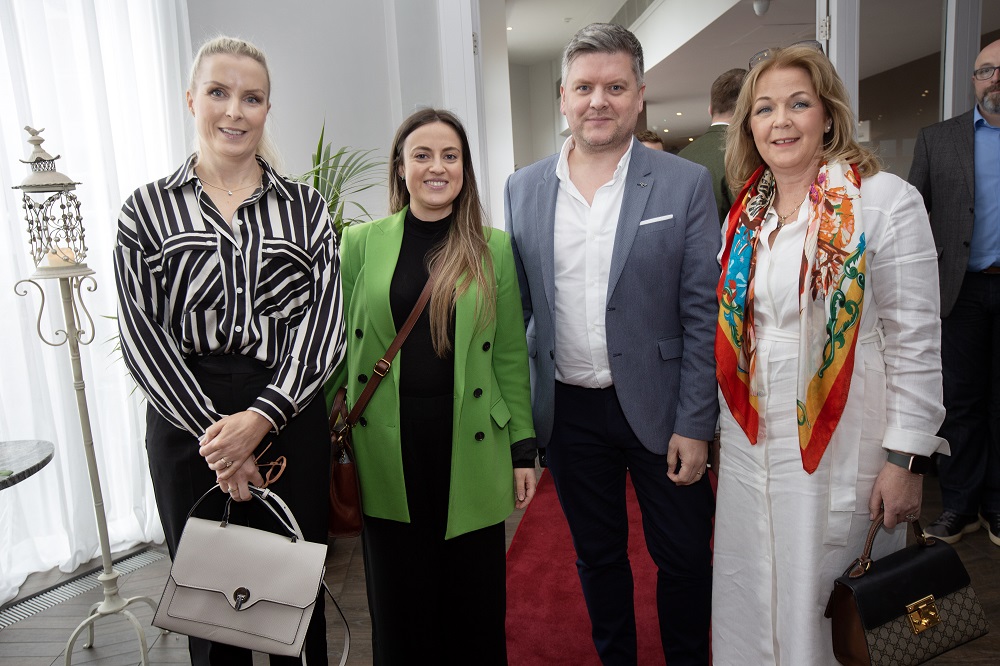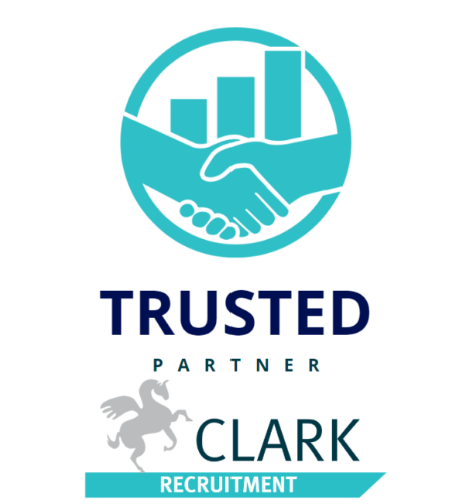2023 Presidents Lunch – Kildare Chamber Event
We were delighted to recently attend the Presidents Lunch in the Osprey Hotel, Naas, kindly sponsored by one of our key clients Endress+Hauser. Being a corporate member of the chamber has allowed our business to engage and connect with so many local Kildare businesses. This year we celebrate our 25th year in business and gathering at this event allowed us catch up with so many of our Trusted Partner clients.
Pictured: Niamh Flynn, Senior Recruiter Accountancy, Finance, Tax, Compliance and Professional Services, Niamh Gaffney Recruiter Engineering and Operations, Stephen Farrell O’Callaghan Director and Deirdre Coghlan Murray MD.
Recruiters – we want to speak with you!
We’re looking for…Recruiters! Senior, Mid level and those seeking a foot on the recruitment ladder! Call Clark today!
Who are we looking for and what will you have:
People with a proven track record in the recruitment industry or those looking to kick start their recruitment career and learn from our recruitment experts.
You will be commercial and have a desire to help people succeed and companies to thrive.
You will have an ability to develop and manage existing key accounts and deliver effective partnership solutions for our clients located throughout Ireland with a key focus on Mid Leinster.
You will be someone who enjoys a very busy working environment and who thrives on measuring up to the best.
We work in an environment where excellence is recognised, rewarded and hidden skills are identified and utilised.
You will enjoy dealing and working closely with people, have a natural ability to connect and network and really enjoy the challenges of finding the very best talent in a highly competitive marketplace like we are experiencing now.
The ideal people for these roles will have experience working in the recruitment industry and/or come from client relations, retail, customer service, hospitality, account mgt or a business development background.
You will enjoy the process of deep diving and unearthing the potential of our candidates and deliver a customised service to both our clients and candidates alike using the best technology, automations and availing of the best marketing support in our profession.
Essential to this role will be you, your attitude, your personality and most of all your ability to be persistent and have the eagerness to ride the rollercoasters that recruitment offer.
Call Stephen Farrell-O’Callaghan or Sarah Mortimer today on 045 881888 or email stephen@clark.ie or sarah@clark.ie
#recruitment #technology #marketing #people #career
How to Live an Authentic Life Fuelled with Purpose and Balance
In our fast-paced world, it’s easy to get caught up in the daily grind and forget what truly matters in life. We often find ourselves overstretched and overwhelmed, desperately trying to keep up with the demands of work, family, and social obligations. But true happiness comes from living an authentic life fuelled with a sense of purpose and balance.
Here are some tips for living an authentic life from Managing Director and Executive Coach, Deirdre CoghlanMurray.
1. Define your values: Take some time to reflect on what’s truly important to you. What do you value most in life? Is it family, friends, career success, personal growth, or something else entirely? Once you’ve identified your core values, make sure that your actions align with them.
2. Set goals: Having goals is essential for staying motivated and focused on what you want to achieve. Make sure your goals are specific, measurable, achievable, relevant, and time-bound (SMART). Write them down and review them regularly.
3. Prioritise self-care: Taking care of your physical and emotional health is crucial for living an authentic life. Make sure that you’re getting enough sleep, eating well-balanced meals, exercising regularly, and taking breaks when needed.
4. Cultivate meaningful relationships: Surround yourself with people who share your values and support your goals. Invest time in building deep and meaningful relationships with family members, friends, colleagues or mentors who inspire you.
5. Embrace change: Change is inevitable in life but can be challenging to navigate at times. Accepting change as a part of the natural flow of things can help us grow personally while staying true to our values.
6. Live intentionally: Be mindful of how you spend your time and energy each day; don’t waste it on things that don’t bring joy or fulfilment into your life.
By following these tips for living an authentic life fuelled with purpose and balance will help you create a fulfilling and meaningful life. You’ll be happier, healthier, and more successful in all areas of your life.
For more information on our one on one coaching programs, team coaching and events, reach out to Deirdre on
or email deirdre@clark.ie
Deirdre holds an MSc in Executive Coaching & Behavioural Change through Henley Business School (Reading University) and is a graduate of Business Management with over 30 years HR, Recruitment & Selection and Coaching experience both nationally and internationally. She is the Managing Director of one of Irelands leading Recruitment and HR Service’s company established since 1998. Her experience spans both global and local organisations with exposure to Multinational Best Practice and SME’s. Her passion for helping people get the best out of themselves is contagious. Deirdre’s coaching practice is based on a strong code of ethics founded on confidentiality and a clear coaching contract. She is also an accredited Time to Think, Systemic Coaching and IMX Psychometric profiler.
What is a Trusted Partner and why consider Clark?
In the ever-changing world of business, it has become increasingly important for companies to have trusted partners. A trusted partner can help businesses navigate through tough times and ensure that they’re making the right decisions for their organisation.
But what exactly is a trusted partner? And why should businesses consider partnering with one? In this article, we’ll explore the benefits of having a trusted partner and how they can help your business grow.
What is a Trusted Partner?
A trusted partner is someone who understands your business, shares your goals and has similar values, and works alongside you to achieve key objectives such as managing your recruitment process in partnership. They are an extension of your team and bring expertise in areas where you may lack knowledge or experience.
Benefits of Having a Trusted Partner
One of the biggest benefits of having a trusted partner is access to their expertise. They can provide insights into industry trends, best practices, and strategies that have worked for other organizations similar to yours.
Additionally, working with a trusted partner can save you time and resources. Instead of spending valuable time researching solutions or trying different approaches, you can rely on your partner’s knowledge and experience to streamline processes and make informed decisions quickly.
A trusted partner also provides an outside perspective on your business. They may notice blind spots or areas for improvement that you wouldn’t have identified otherwise. This feedback can be invaluable in helping your business grow and evolve.
Finally, having a trusted partner fosters collaboration and builds long-term relationships. When both parties are committed to each other’s success, it creates a sense of trust that goes beyond just the current project or engagement.
How to Choose a Trusted Partner
Choosing the right partner is crucial for reaping the benefits mentioned above. Here are some things to consider when selecting a trusted partner:
- Compatibility: Look for someone who aligns with your values and has a similar approach to business.
- Expertise: Ensure that your partner has the expertise and experience necessary to help you achieve your goals.
- Communication: Open communication is vital for a successful partnership. Make sure that you feel comfortable expressing concerns or asking questions.
- Trustworthiness: Your partner should be transparent, reliable, and trustworthy. Look for references or testimonials from other clients.
In today’s fast-paced business world, having a trusted partner can be the difference between success and failure. By providing expertise, saving time and resources, offering an outside perspective, and building long-term relationships, a trusted partner can help your business grow and thrive. When choosing a trusted partner, it’s essential to find someone who aligns with your values, has the necessary expertise, communicates openly, and is trustworthy.
Choose a Trusted Partner like Clark when you are next looking to recruit and let us showcase why so many other companies since our foundation in 1998 consider us a trusted partner.
Spread the word – our client is hiring!
We’re looking for a Senior Content Creator to join our clients team in Carlow, and we need someone with the energy, creative flair, and technical ability to be the driving force behind all social platforms and marketing campaigns for our clients business.
As a hybrid worker, you’ll have the flexibility to work both from home and in the office, while being part of a dynamic team that is passionate about delivering high-quality content.
If you’re interested in this exciting opportunity, reach out to us today.
Speak with Edel or Stephen on 045 881888 to learn more about what we’re looking for and how you can contribute to our growing success.
For more information on this position click Job Profile | Recruitment | Clark Recruitment and to view other positions visit our website www.clark.ie
Achieving Work-Life Balance: Tips for Managers and Employees
Work-life balance is a term that’s thrown around a lot, but what does it actually mean? At its core, work-life balance is about finding a stable and sustainable way to work while maintaining your health and general well-being.
While there’s no one-size-fits-all formula for balancing work and life, it’s important to strive for a sense of fulfilment in both areas of your life. This means that neither your personal nor professional life should dominate the other, and you should feel energised by what’s in store for you each day.
As a manager, it’s important to not only find this balance for yourself but also to help your employees find their own balance. Here are some tips to help you achieve work-life balance:
1. Prioritize Meaningful Work
Doing meaningful work is one of the keys to feeling fulfilled in your job. It helps you feel like what you do matters and that you’re making a positive contribution. As a manager, make sure your employees understand how their work fits into the bigger picture and how it contributes to the company’s goals.
2. Encourage Hobbies
Finding fulfilment outside of work is just as important as finding it within your job. Encourage your employees to pursue hobbies outside of work that they enjoy. This could be anything from painting to hiking or playing music.
3. Foster Restoration
Restoration is essential for maintaining energy and focus throughout the day. Encourage employees to take breaks throughout the day, whether it’s going for a walk or meditating during lunchtime.
4. Be Flexible
Everyone has different needs when it comes to achieving work-life balance, so be flexible in accommodating those needs. Offer flexible schedules or remote work options if possible.
5. Listen Attentively
The key to helping employees achieve work-life balance is attentive listening. Take the time to really understand your employees’ needs and concerns, and work with them to find a solution that works for everyone.
In conclusion, achieving work-life balance is essential for maintaining your health and well-being. As a manager, it’s important to lead by example and help your employees find their own balance. By prioritising meaningful work, encouraging hobbies, fostering restoration, being flexible, and listening attentively, you can create a workplace culture that values work-life balance.
Clark create information and articles and share on all of our social channels. For more information reach out or visit www.clark.ie
How to Build a Great Team: Tips and Strategies for Success.
Building a great team is crucial for achieving success in any business. A well-functioning team can help you achieve your goals, increase productivity, and drive innovation. However, building a great team is not an easy task. It requires careful planning, effective communication, and strong leadership. In this article, we’ll explore some tips and strategies for building a great team that can lead your business to success.
1. Define Your Vision and Goals
Before you start building your team, it’s important to define your vision and goals. This will help you identify the skills and expertise required for each role in your team. It will also enable you to create a clear job description that outlines the responsibilities of each team member.
Your vision should be inspiring and motivating for your team members. It should be something that everyone can rally behind and work towards achieving together. When defining your goals, make sure they are specific, measurable, achievable, relevant, and time-bound (SMART). This will help you track progress and measure success.
2. Hire the Right People – partner with Clark of course!
Hiring the right people is critical to building a great team. You need people who have the skills, experience, and personality traits required for each role in your team. Hiring for cultural fit is also important as it ensures that everyone shares similar values and works well together.
When hiring new employees, make sure you have a rigorous selection process in place that includes multiple interviews, reference checks, skills assessments, and background checks if necessary. Don’t rush the hiring process as making the wrong hire can be costly in terms of time and resources. To add to that don’t delay the process too long or you will miss out on great candidates!
3. Encourage Collaboration
Encouraging collaboration among team members is essential for building a great team culture. When people work together towards a common goal, they are more likely to produce better results than when working alone.
To encourage collaboration within your team, create opportunities for people to work together on projects or tasks. Use team-building exercises such as brainstorming sessions or group problem-solving activities. Encourage open communication and make sure everyone has a chance to contribute their ideas and opinions.
4. Provide Ongoing Training and Development
Providing ongoing training and development opportunities for your team members is important for keeping them engaged and motivated. It also ensures that they have the skills and knowledge required to perform their roles effectively.
Offering training programs, workshops, or online courses can help your team members develop new skills and stay up-to-date with industry trends. Providing opportunities for career progression within your organization can also help retain talented employees.
5. Recognise and Reward Achievements
Recognising and rewarding achievements is important for boosting morale and motivating your team members. Celebrate successes, both big and small, such as completing a project on time or exceeding sales targets.
Recognition doesn’t always have to be monetary; it can be as simple as saying thank you or giving a shout-out in a company newsletter. Just make sure you are consistent in recognising achievements across all teams to avoid any feelings of favouritism.
In conclusion, building a great team requires careful planning, effective communication, strong leadership, collaboration, ongoing training and development, and recognition of achievements. By following these tips and strategies, you can create a high-performing team that drives success for your business.
Clark are 25 years in business this year and we have the key skills, expertise and knowledge to help you build your best team.
Economic outlook looking positive
Last month, the European Commission formally revised its expectation for the performance of the Irish economy, as part of its Winter 2023 Economic Forecast. Ireland’s GDP growth for 2023 is now predicted to reach 4.9% with 4.1% growth forecast for 2024. Speaking to Ireland’s economic development, the Commission noted that overall indicators point towards a more positive outlook than was previously expected. This is driven, in part, by falling inflation towards the end of 2022. Despite a number of Ireland’s most prominent technology companies announcing further staff reductions, the Commission cited Ireland’s low unemployment rate as evidence of a well-performing economy. On the multinational sector, the Commission noted that “foreign investment in the first half of 2023 is set to be strong, as signalled by IDA Ireland, while a brighter global outlook is set to support exports”.
Information sourced through the Irish Australian Embassy

Shortage of accountants ‘to worsen’ in 2023
Chartered Accountants Ireland is warning that an acute shortage of qualified accountants will worsen in 2023, as Irish businesses struggle to access talent.
The institute is highlighting the problem ahead of its annual dinner in Dublin tonight.
President of Chartered Accountants Ireland Pat O’Neill said that the shortage is driven by a huge increase in competition for talent from non-accounting roles but also a gap in perception of what accountants actually do.
“Anecdotally, the talent pipeline problem is clear right across the profession, from practices of all size to industry, resulting in attraction and retention challenges, not just in Ireland, but around the world, and we are working with global partners to tackle it,” Mr O’Neill said.
Chartered Accountants Ireland is calling for reforms of accountancy at Leaving Cert level to encourage more students to enter the profession.
“Accounting has remained set in stone, essentially unchanged in 30 years, so it is little wonder that students don’t associate the profession with cutting edge areas like data analytics or sustainability reporting, both of which are huge growth areas for us,” Mr O’Neill said.
“In speaking to students, many pursued accounting at third level despite, not because of, their experience at second level.”
“Anecdotal feedback has been that many are turned off because of rote learning, the lack of breadth of what is taught and the need to unlearn and relearn concepts on transition to third level,” he added.
(Source www.rte.ie)
Managers Have Major Impact On Mental Health: How To Lead For Wellbeing
New data suggests that for almost 70% of people, their manager has more impact on their mental health than their therapist or their doctor—and it’s equal to the impact of their partner. If you’re a leader, you’re right to find this data sobering.
The stakes for leadership have always been high, but knowing you’re affecting people that much, is cause for leaders to take stock and ensure they’re doing all they can to be their best and have their most positive impacts on people.
Mental Health Matters
According to 69% of people, their managers had the greatest impact on their mental health, on par with the impact of their partner. And this was more than the impact of their doctor (51%) or therapist (41%). This is according to a new study by The Workforce Institute at UKG which included 3,400 people across 10 countries.
A large number of people are affected by stress. In fact, according to the study, 43% of employees report they are exhausted, and 78% say stress negatively impacts their work performance. Other aspects of life are also affected as 71% say stress at work negatively impinges on their home life, 64% say it detracts from their wellbeing and 62% say it degrades their relationships.
In addition to the human reasons to pay attention to mental health, business also benefits. When people have positive mental health, 63% say they are committed to their work and 80% say they’re energized.
The Leadership Role
Leaders have a critical role to play in contributing to the conditions for positive mental health—their own and others’. Here are the most impactful approaches.
Manage Yourself
Many leaders try to shield team members from stress or challenge by taking on the toughest work—or the extra work—themselves. In addition, they can put in long hours and intrude on their own boundaries in the process. In fact, 35% of leaders in the Workforce Institute study reported they are stressed at work and 42% felt it was because of the stress they put on themselves.
As a leader, say no to too much work for yourself or your team, and resist the urge to take on the work yourself. People watch how you manage your own workload and they use your choices as a model—whether you mean them to or not. So avoid overloading yourself. Train others, delegate, empower and ensure teamwork and coordination with other groups so everything doesn’t fall on your shoulders.
Recognize Your Impact
The research also found a third of people say their manager fails to recognize their own impact on others’ wellbeing. Be aware of the leadership laser. People are influenced by everyone around them, but leaders have an outsize impact—and people tend to put leader behaviour under a microscope, paying especially close attention to what leaders say and do.
Emphasize empathy because it’s the right thing to do, and because it has positive impacts on innovation, engagement and retention. Ask people how they’re doing, tune in when you see they may be out of sorts or when they may need support because they’re working on an especially challenging problem.
In addition, connect people to resources—whether it’s an employee assistance program, the HR team or programs to support them. According to the Workforce Institute study, 70% of people would like their manager to do more to support mental health—and these are ways you can do just that.
Click to read the full article:
















